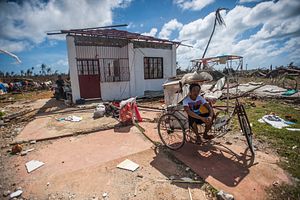The Philippines is one of the most climate change prone countries, facing 20 cyclones every year with five having the potential to turn into megastorms such as Haiyan. During these times television, radio, and newspapers serve as the primary means to pass critical information. As storms become more powerful with each successive year traditional modes of communication have began to falter and the best way to likely reach affected Filipinos will be through phones.
When I recently traveled to the Philippines to study technology use in disaster response I found that existing emergency phone protocols lacked relevance and timeliness which artificial intelligence algorithms could be best suited for. One expert in disaster response I spoke to mentioned that survivors of storms in the recent past had received as many as 300 messages from the beginning of the storm through recovery efforts, rendering the communication means ineffective.
From the moment a disaster is declared, the disaster response authorities pass critical messages via telecom carriers to keep Filipinos informed. The primitive messaging system relays basic information such as rainfall levels and misses out on providing more nuanced insights. After speaking to several government and nonprofit leaders, shelter, disease prevention, safety, weather, navigation, and food and water are universal needs among the affected populace. Let’s take shelter to illustrate how machine-learning (ML) can prepare people to stay in their homes. Many Filipinos choose to stay even in precarious situations as squatters may usurp their land if they leave.
Based on the location of the phone, a machine can put together a mosaic of data including the types of houses common to the area, timing and ferocity of storm surges, and proven adaptation measures in the area to recommend unique mitigation measures specific to the area. If the machine expects a high likelihood of a total home loss situation, the system can notify people and recommend immediate evacuation. Disease prevention can be handled in the same manner. Using various data attributes, a deep learning model could study several complex factors such as the rate of infection and spread, water sanitation in the area, the community’s current health preparedness, medical attention availability, and education levels to determine how communities can arrest the spread of disease.
In some ways ML is already at work during disasters. For example, Facebook’s “I’m Safe” and “Give Help” features provide means for people to connect and give and get help and serves as an excellent means for Filipinos to communicate in the recent storms. However, providing advice based on local conditions is barely scratching the surface of machine-learning possibilities. Personalization on individuals’ preferences is the next frontier as it will change what message is delivered, how sympathy is conveyed, and which services are offered.
National disaster agencies are not currently equipped to conduct data collection, curation, and processing for effective machine-learning deployment. In addition, this approach could open the door for the government to collect substantial sensitive data on the public and potentially misuse it. Creating a strong, independent organization to drive AI innovation under the NDRRMC (National Disaster Risk Reduction and Management Council) could alleviate such issues. This AI division could partner with social media companies such as Project Argos, and the broader private sector, to accelerate machine-learning capabilities to provide timely insights for survivors.
A challenge to an ML-driven disaster response world is the lack of smartphone usage in every household. Current smartphone penetration in the Philippines is approximately 50 percent, precluding data collection which serves as the backbone of AI. The good news is that that number will quickly rise in the next few years. A more persistent problem is cell phone outage during storms as above ground power and phone lines are frequently ripped apart. Technology companies have experimented with new modes to connect people from wifi hotspots to underground fiber to the more futuristic solar-powered internet drones (drones have already made an appearance in disaster areas in the Philippines). The United States has already set a strong precedent to use drones after disasters in various applications such as insurance claims and disaster recovery. These drones could easily be linked to ML models that can provide rich real-time insights.
Filipinos deserve better than their current antiquated system and the good news is that the technology is widely available today in open-source. The cultural notion to achieve zero casualties after a storm will be near impossible unless the country gets machine-learning, and other emerging technologies, absolutely spot-on.
Chetan Peddada is a product manager in the machine-learning domain for a Fortune 75 company. The views expressed in this article are of the author’s alone and do not reflect those of his employer. Special thanks to the Carnegie Council for Ethics in International Affairs and the Henry Luce Foundation for supporting research on climate change.

































